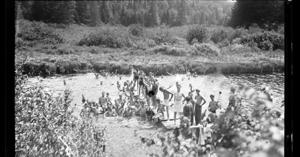The young men of Fulton County took advantage of this opportunity, registering at either the Red Cross offices or with the Commissioner of Public Welfare. The cities of Gloversville and Johnstown each had 10 vacancies available — later boosted to 15 — with enlistees serving six months. All men were required to pass a medical inspection before being assigned to a camp.
The first group of six left from Johnstown on May 19, 1933. That September, six young men from Gloversville were stationed in Idaho and “satisfied with the conditions there,” according to a letter from Joseph Marcoux. CCC camps were established all over the country.
The two closest to our area were at Shaker Place in Arietta (the first one in the Adirondacks) and Piseco. Arietta itself is less than three miles from the county line, and the Shaker Place camp 10 miles north from there. Because of the proximity, this CCC camp — Company 219 — interacted frequently with Fulton County and its residents.
A look at the Arietta Civilian Conservation Corps Camp. The Morning Herald announced that businesses were invited to submit bids for meat, eggs and bread for the two camps. Paperwork could be obtained at the post office and submitted to the quartermaster at Fort Jay.
The camps at Arietta and Piseco each needed 5,000 lbs. of bread, supplied in loaves of one pound each, as well as 500 lbs. of bacon, 60 cases of eggs, 300 lbs.
of ham, 400 lbs. of roasting chicken, 300 lbs. of fowl, 100 lbs.
of beef liver, 300 .


















